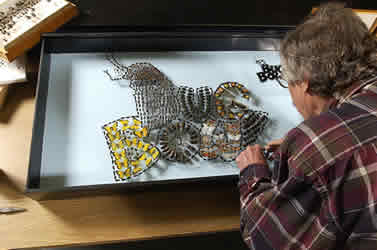Boiler Bug Barn to provide insect outreach year round
By Tom Campbel
AgComm
January 24, 2006
 |
| Entomology Professor Tom Turpin makes a Bug Bowl collage out of insects found near his home, showing the diversity of insects in our backyards. |
WEST LAFAYETTE, Ind. - The Bug Bowl, Purdue University's wildly popular, one-weekend-in-spring tribute to all things creepy and crawly, now has a year-round home. The Boiler Bug Barn officially opened its doors inside Smith Hall last week.
The center is located in Smith Hall, Room 124, on the West Lafayette campus. It is open from 8 a.m. to 5 p.m., Monday through Friday.
Purdue's Department of Entomology created the Boiler Bug Barn as an outreach endeavor that extends beyond Bug Bowl, which attracts thousands of visitors to campus each year as part of the Spring Fest celebration, which this year will be April 8-9.
"Bug Bowl has been a tremendous event for our department and for the university," said department head Steve Yaninek. "But that is just one weekend. Our efforts reach beyond events like Bug Bowl. We're now working with teachers and other professional educators to promote science literacy by linking insects, informal education and K-12 classroom science standards in a novel program."
The Boiler Bug Barn is part of the Entomology Outreach Center and is located in entomologist Tom Turpin's old laboratory, converted into a visitor center chock full of insect collections, unusual memorabilia such as turn-of-the-century teaching tools and a bee tree.
"The new center will give our science education clientele and the general public a physical location on campus for year-round contact to the program," Yaninek said.
Turpin thinks individuals and groups alike will enjoy the Boiler Bug Barn.
"We get lots of requests throughout the year," Turpin said. "Sometimes it's from groups touring campus like 4-H or FFA, so we think it can be a benefit to student recruiting. But we also get people who come to campus with their children or grandchildren and ask to see the insect collections. So this is a place where we can display things we do during Bug Bowl."
Visitors will see what Turpin calls the "Oh My! insect collection," which includes the Goliath beetle - the world's largest insect - and showy insects from Indiana and the world, such as tarantulas, millipedes and even insect-eating plants.
Much of the Bug Barn is based on the Entomology 105 course, "Introduction to Insect Friends and Foes."
"It's a combination of the science and humanity of insects," Turpin said.
The Boiler Bug Barn is also a working lab. A 5-foot section of a red oak tree occupies a corner of the Bug Barn. Turpin estimates the log to be almost as old as the university itself, planted over 150 years ago.
A quarter of the hollow log has been cut away, replaced by a sheet of glass that keeps several thousand very active bees safely inside the log.
"This will also be an educational tool for our students, where they can observe and learn about honey bee behavior," Turpin said.
Writer: Tom Campbell, (765) 494-8084, tsc@purdue.edu
Sources: Steve Yaninek, 765 49-44554, yaninek@purdue.edu
Tom Turpin, turpin@purdue.edu
Ag Communications: (765) 494-2722;
Beth Forbes, forbes@purdue.edu
Agriculture News Page |